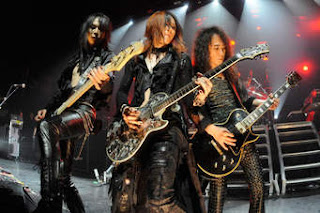X
Japan was one of the most influential rock bands in Japanese history.
Formed as a speed metal band in the early ‘80s, the group attracted
attention not only for its music, but also its popularization of visual
kei, a cultural/musical/fashion movement whose emphasis on outrageous
hairstyles and androgynous makeup was similar to glam rock. By the early
'90s, X had also woven power ballads, pop, and classical music into the
band’s catalog, creating a sound that helped the group enter — and, for
several years, dominate — the Japanese mainstream.
Before
signing with a major label in 1988, X was one of the country’s first
independent acts to achieve national success. Childhood friends Yoshiki
Hayashi and Toshimitsu Deyama formed the band as high school students,
and Yoshiki established his own label, Extasy Records, to release the
group’s material. With lead guitarist Hide (aka Hideto Matsumoto),
rhythm guitarist Pata (aka Tomoaki Ishizuka), and bassist Taiji (aka
Taiji Sawada) filling out the lineup, X released several singles and one
full-length album, 1988’s Vanishing Vision, before signing with Sony
toward the end of the decade. The group’s major-label debut, Blue Blood,
appeared in 1989.
Blue Blood went multi-platinum on
the strength of three hit singles. The band’s follow-up effort,
Jealousy, was similarly popular, becoming the 12th bestselling album of
1991 despite its mid-year release. With the intention of breaking into
international markets, X lengthened its name to X Japan (a decision
meant to distinguish the Japanese group from the similarly named
American punk band) and signed a new contract with Atlantic Records. The
guys also hired bass player Heath (aka Hiroshi Morie) to replace the
departing Taiji. Drawing from the classical background of Yoshiki, who’d
emerged as the band’s leader, X Japan returned in 1993 with Art of
Life, a symphonic album consisting of one long, eclectic, 29-minute
track. Yoshiki also released a second symphonic album in 1993, working
with producer George Martin to produce classical arrangements of several
X Japan songs. Released later that year, Eternal Melody became the
best-selling classical record in Japanese history. Meanwhile, Hide,
Heath, and Toshi all released their own solo discs, with Hide's Hide
Your Face enjoying the most popularity.
When X Japan
returned in 1996 with Dahlia, the band both looked and sounded
different. With the exception of Hide, who continued to favor the visual
kei style, the musicians had largely abandoned the use of outrageous
hairstyles and flashy costumes. They’d also pushed their sound into
smoother territory, favoring ballads that highlighted Yoshiki’s piano
playing and Toshi’s vocals over fast, furious rock songs. Even so,
Dahlia proved to be one of X Japan’s most popular albums to date; four
singles topping the Japanese charts, and another song, “Tears,” peaked
at number two.
X Japan had become a national
institution by the mid-‘90s, but the band nevertheless pulled the plug
in September 1997, with Toshi announcing his desire to leave the group
and pursue music on a much smaller level. Several months later, the band
held its final performance at the Tokyo Dome on New Year’s Eve. In the
months that followed, Hide quietly emerged as the band’s busiest alum,
playing shows in support of his second solo release and even forming an
American-based side project named Zilch. He died in May 1998, however,
the victim of an apparent suicide.
Nearly ten years
after Hide’s death, X Japan began laying the foundation for a reunion.
Former Luna Sea guitarist Sugizo, who’d helped popularize the visual kei
movement alongside X Japan during the '90s, was brought aboard as the
group’s newest member, and the band began holding rehearsals in
mid-2007. By the end of the year, they’d recorded a new song, “I.V.,”
and an international tour followed.




Tidak ada komentar:
Posting Komentar